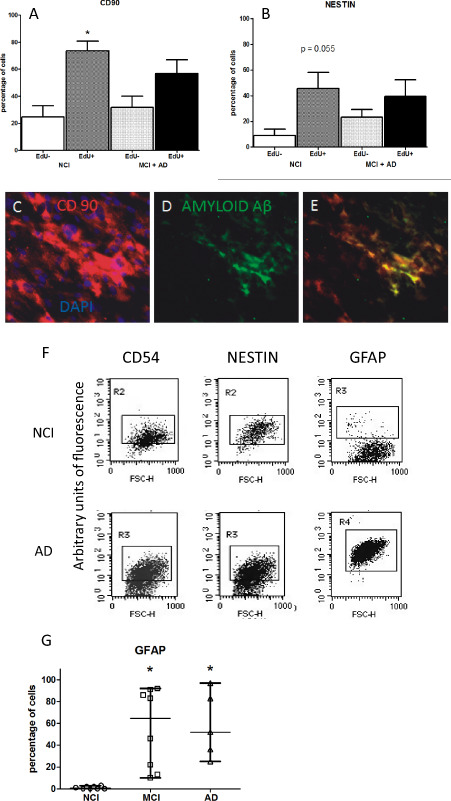Figure 7.

Amyloid A β expression may affect proliferation of EdU ‐labeled cells in A lzheimer's disease ( AD ) and is detected in mesenchymal stromal cells. Olfactory cells pulsed with EdU, a thymidine mimetic compound, evidenced that Alzheimer and mild cognitive impairment (MCI) condition precluded proliferation of CD90+ and NESTIN + mesenchymal stromal cells. The percentage of EdU +, CD90+ cells as indicative of proliferative subpopulation of cells was different with respect to EdU −,CD90+ in the noncognitive impaired (NCI) group (P < 0.049) (A). Although the percentage of EdU +, CD90+ was also elevated in the MCI and AD subjects, it was not different with respect to EdU −, CD90+ population of cells. The percentage of EdU −, NESTIN + population of cells in the MCI + AD group of subjects was not different with respect to EdU +, NESTIN + cells. A statistical value of P < 0.055 was determined when EdU +, NESTIN + with respect to EdU −, NESTIN + in the NCI group (B). No differences were found in the percentage of EdU −, NESTIN + population of cells between the NCI and MCI + AD group of subjects. Mesenchymal stromal cells (MSCs) were plated in coverslips by 7 days in vitro then fixed and examined by CD90 and amyloid Aβ immunostaining. A higher percentage of olfactory cells from AD subjects expressed CD90, a typical marker of MSCs (C). Amyloid Aβ peptide is immunolocalized in a subpopulation of CD90+ cells (D, E). Olfactory‐cultured cells from NCI, MCI and AD patients expressed markers of olfactory precursor (CD54) and neural progenitor cells [NESTIN and glial fibrillary acidic protein (GFAP)] (F). The median of GFAP olfactory stromal cells was different between AD, MCI and NCI groups of patients [Kruskall–Wallis test (P < 0.0008; 3, 14.35)] (G). The percentage of GFAP‐immunolabeled cells of AD and MCI was different with respect to NCI group (P < 0.05 Dunn's test). Cytograms are representative of multiple independent determinations.
